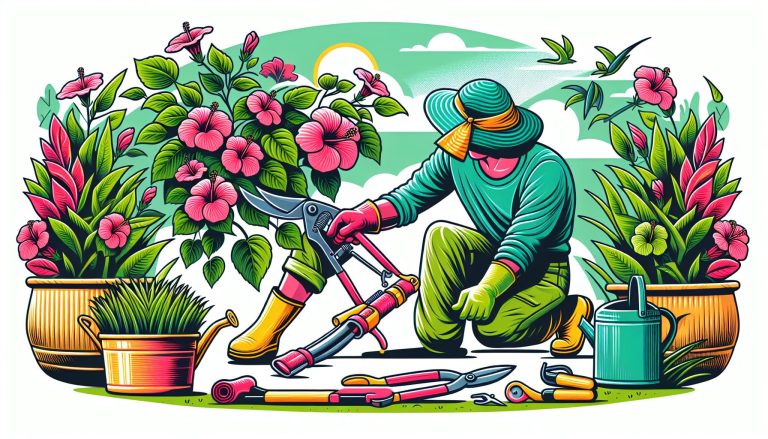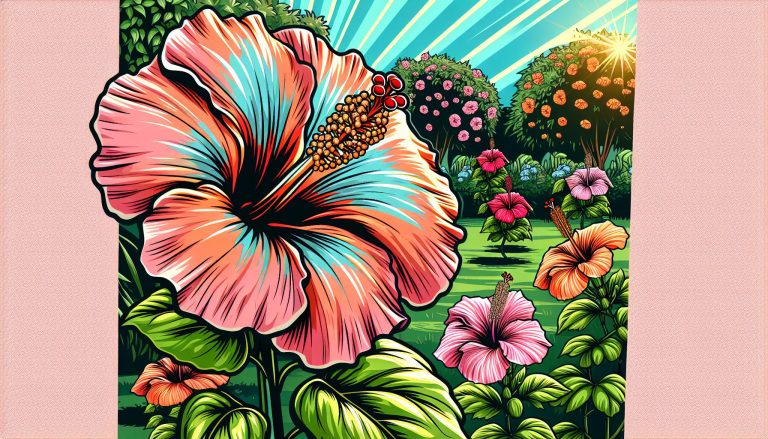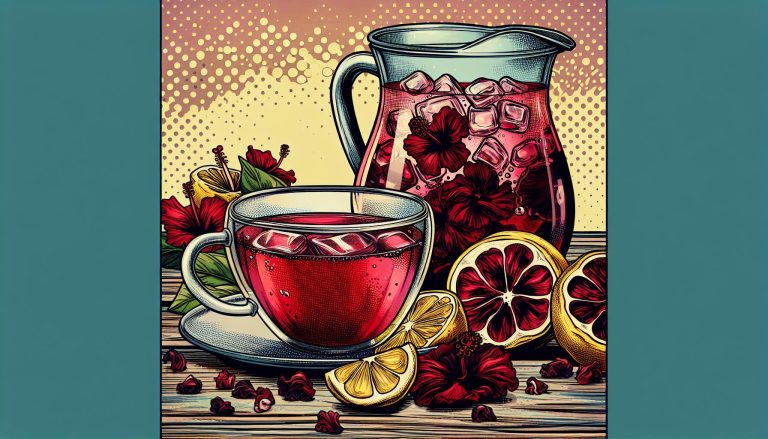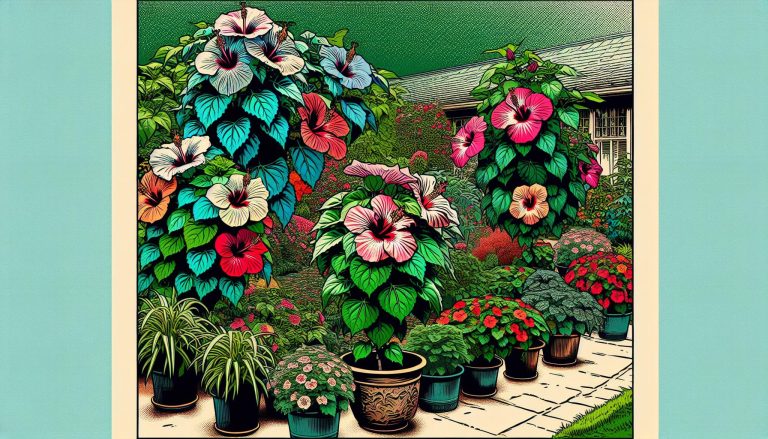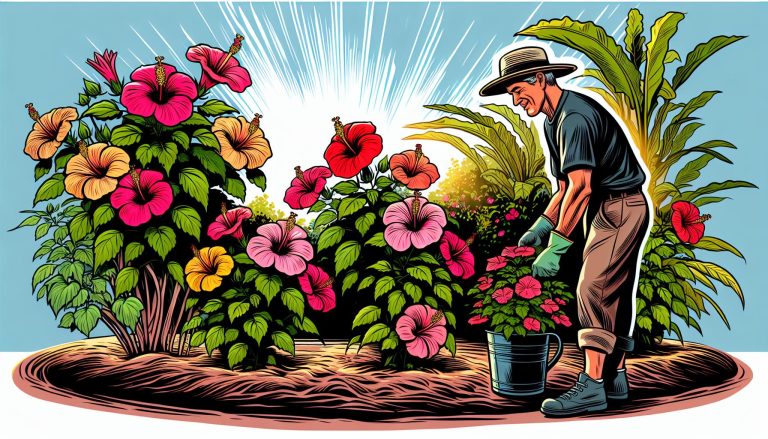Do Deer Eat Hibiscus? Protect Your Garden’s Showstoppers
As a passionate gardener, I’ve often wondered about the relationship between wildlife and our beloved plants. One question that frequently comes up is: do deer eat hibiscus? It’s a valid concern, especially if you’re planning to add these vibrant flowers to your garden.
Hibiscus plants are known for their stunning, large blooms and tropical flair. But their beauty can also attract unwanted visitors. In this article, I’ll explore whether deer have a taste for hibiscus and what you can do to protect your prized plants. We’ll dive into deer feeding habits, the appeal of hibiscus to these graceful creatures, and practical solutions to keep your garden blooming beautifully.
Understanding Deer Feeding Habits
Deer feeding habits are complex and influenced by various factors. To effectively protect hibiscus plants, it’s crucial to understand what deer typically eat and why they choose certain plants over others.
Common Plants in Deer Diets
Deer are herbivores with a diverse diet that includes:
- Leaves: Oak, maple, and dogwood
- Fruits: Apples, berries, and persimmons
- Nuts: Acorns, chestnuts, and beechnuts
- Flowers: Tulips, daylilies, and hostas
- Vegetables: Lettuce, peas, and beans
- Grasses: Fescue, bluegrass, and ryegrass
These plants provide essential nutrients and are often readily available in deer habitats. Deer prefer tender shoots, buds, and new growth, which are easier to digest and more nutritious.
Factors Influencing Deer Food Choices
Several factors affect deer’s food preferences:
- Seasonality: Deer adjust their diet based on available plants throughout the year.
- Nutritional needs: Pregnant does and growing fawns require more protein and minerals.
- Palatability: Deer favor plants with higher sugar content and fewer bitter compounds.
- Accessibility: Easily reached plants are more likely to be consumed.
- Population density: Higher deer populations lead to increased competition for food sources.
- Weather conditions: Drought or harsh winters can force deer to eat less preferred plants.
- Human activity: Landscaping and agriculture can introduce new food sources to deer habitats.
Understanding these factors helps predict deer behavior and develop effective strategies to protect hibiscus and other vulnerable plants in gardens and landscapes.
Hibiscus: An Attractive Plant for Gardens
Hibiscus plants are prized for their stunning, large flowers and lush foliage. These versatile plants add a tropical flair to gardens, attracting both human admirers and wildlife.
Types of Hibiscus Plants
Hibiscus plants come in three main varieties: tropical, hardy, and rose of Sharon. Tropical hibiscus (Hibiscus rosa-sinensis) boasts vibrant, exotic flowers in shades of red, pink, orange, and yellow. Hardy hibiscus (Hibiscus moscheutos) thrives in colder climates and produces dinner plate-sized blooms. Rose of Sharon (Hibiscus syriacus) is a shrub-like variety with smaller flowers that bloom late in the season. Each type offers unique characteristics, making hibiscus suitable for various garden designs and climates.
Hibiscus Nutritional Value
Hibiscus plants contain a rich array of nutrients, making them appealing to both humans and wildlife. The flowers and leaves are packed with vitamin C, antioxidants, and minerals like calcium and potassium. Hibiscus tea, made from the plant’s calyces, is known for its high levels of anthocyanins and flavonoids. These compounds contribute to the plant’s potential health benefits, including supporting cardiovascular health and boosting the immune system. The nutritional content of hibiscus also makes it an attractive food source for deer and other herbivores, especially during times when other vegetation is scarce.
Do Deer Eat Hibiscus?
Deer do eat hibiscus plants, often targeting the tender leaves, buds, and flowers. Their consumption of hibiscus depends on factors like food availability, season, and individual preferences.
Evidence of Deer Consuming Hibiscus
Numerous gardeners report deer damage to their hibiscus plants, with clear signs of browsing on leaves and flowers. Bite marks on stems, stripped foliage, and missing buds are telltale indicators of deer activity. Trail cameras and direct observations have captured deer feeding on hibiscus in both residential gardens and natural settings. Deer droppings found near damaged hibiscus plants provide further evidence of their consumption.
Preferred Hibiscus Varieties for Deer
While deer may eat various hibiscus types, they show preferences for certain varieties:
- Hardy Hibiscus: These large-flowered perennials are particularly attractive to deer.
- Rose of Sharon: A common target for deer, especially the tender new growth.
- Tropical Hibiscus: Less preferred but still consumed when other food sources are scarce.
Deer favor hibiscus varieties with softer leaves and more succulent stems. They’re drawn to plants with higher water content and nutritional value. Hybridized varieties, often bred for larger blooms and more tender foliage, are typically more appealing to deer than native species.
Impact of Deer on Hibiscus Plants
Deer can have a significant impact on hibiscus plants, often causing extensive damage that affects both the plant’s appearance and overall health. Their feeding habits can lead to immediate visible damage and long-term consequences for the plants.
Damage to Leaves and Flowers
Deer primarily target the tender parts of hibiscus plants, focusing on new growth, young leaves, and flowers. They typically strip leaves from stems, leaving behind jagged edges or bare branches. Flowers are often eaten entirely, with buds being a particular favorite. This damage is most noticeable during spring and early summer when hibiscus plants produce new growth and abundant blooms. In severe cases, deer can defoliate entire plants, leaving behind only woody stems and branches.
Long-Term Effects on Plant Health
Repeated deer browsing can have serious long-term consequences for hibiscus plants:
- Stunted growth: Continuous removal of new growth prevents plants from developing properly, leading to smaller, weaker plants.
- Reduced blooming: Damage to flower buds and constant stress can significantly decrease the plant’s ability to produce flowers.
- Increased susceptibility to disease: Wounds from deer feeding create entry points for pathogens, making plants more vulnerable to infections.
- Weakened root systems: With fewer leaves for photosynthesis, plants struggle to produce enough energy for robust root development.
- Altered plant shape: Repeated browsing can result in an unnatural, stunted appearance as plants attempt to regrow from remaining buds.
These long-term effects can ultimately lead to the decline and potential death of hibiscus plants if deer feeding persists without intervention. Implementing effective protection strategies is crucial for maintaining healthy, thriving hibiscus in deer-prone areas.
Protecting Hibiscus from Deer
To safeguard hibiscus plants from deer damage, I’ll explore effective protection strategies. These methods range from physical barriers to repellent solutions, offering gardeners practical ways to preserve their hibiscus.
Physical Barriers and Fencing
Physical barriers are highly effective in protecting hibiscus from deer. A sturdy fence, at least 8 feet tall, prevents deer from jumping over. For smaller areas, I recommend using wire mesh cages or netting around individual plants. Protective tubes or tree shelters work well for young hibiscus, shielding them during vulnerable growth stages. Electric fencing offers another reliable option, delivering a mild shock to deter deer. For a more aesthetically pleasing solution, consider creating a hedge barrier using deer-resistant plants like boxwood or holly.
Deer-Repellent Sprays and Solutions
Deer-repellent sprays and solutions provide a chemical barrier to protect hibiscus. Commercial repellents containing putrescent egg solids, garlic, or hot pepper effectively deter deer. I suggest applying these sprays every 3-4 weeks and after rainfall for optimal results. Homemade solutions using ingredients like garlic, eggs, or soap offer cost-effective alternatives. Predator urine, such as coyote or fox, mimics the presence of natural deer predators when sprayed around hibiscus plants. For long-lasting protection, consider systemic repellents absorbed by the plant, making the foliage unpalatable to deer for several months.
Deer-Resistant Alternatives to Hibiscus
For gardeners looking to maintain a beautiful landscape while minimizing deer damage, there are numerous deer-resistant alternatives to hibiscus. These plants offer similar aesthetic appeal and thrive in various garden settings without attracting unwanted wildlife.
Plants with Similar Aesthetic Appeal
Several deer-resistant plants rival hibiscus in beauty and charm:
- Butterfly Bush: Large, colorful flower clusters attract pollinators but deter deer.
- Russian Sage: Lavender-blue spikes provide a stunning visual impact and aromatic foliage.
- Coneflowers: Daisy-like blooms in various colors offer long-lasting summer beauty.
- Daylilies: Vibrant, trumpet-shaped flowers bloom prolifically throughout summer.
- Lavender: Fragrant purple blooms and silvery foliage create a stunning visual display.
- Foxglove: Tall spikes of tubular flowers add vertical interest to gardens.
These alternatives boast similar characteristics to hibiscus, such as showy flowers, extended blooming periods, and adaptability to various growing conditions.
Creating a Deer-Resistant Garden
Designing a deer-resistant garden involves strategic plant selection and placement:
- Incorporate strong-scented plants: Lavender, rosemary, and sage deter deer with their aromatic foliage.
- Use textured plants: Fuzzy or prickly leaves, like those of lamb’s ear or barberry, discourage deer browsing.
- Plant in layers: Combine tall grasses, shrubs, and trees to create barriers and protect vulnerable plants.
- Group resistant plants: Cluster deer-resistant species together to create larger, more effective deterrent zones.
- Utilize native plants: Local species often have natural defenses against deer and adapt well to regional conditions.
- Maintain diversity: Mix various deer-resistant plants to create a visually appealing and resilient garden.
By implementing these strategies, gardeners can create beautiful, low-maintenance landscapes that thrive without succumbing to deer damage.
Conclusion
Protecting hibiscus from deer requires understanding their feeding habits and implementing effective strategies. While deer do eat hibiscus I’ve shown that with the right approach you can still enjoy these beautiful plants in your garden. By using physical barriers repellents or opting for deer-resistant alternatives you’ll create a thriving landscape that deters unwanted visitors. Remember that consistency and adaptability are key to success. With these insights and tips you’re well-equipped to cultivate a stunning hibiscus-filled garden that stands up to deer pressure.


